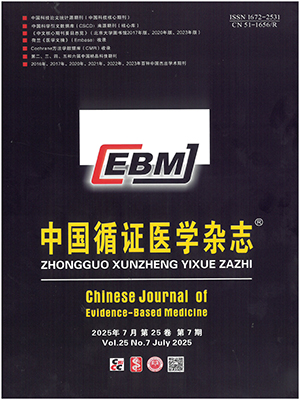| 1. |
Jansen JP, Crawford B, Bergman G, et al. Bayesian meta-analysis of multiple treatment comparisons: an introduction to mixed treatment comparisons. Value Health, 2008, 11(5): 956-964.
|
| 2. |
李伦, 杨克虎. 网状Meta分析相关术语和定义的研究. 中国药物评价, 2014, (6): 321-326.
|
| 3. |
Schünemann HJ, Higgins JP, Vist GE, et al. Completing 'summary of findings' tables and grading the certainty of the evidence. Hoboken: John Wiley & Sons, Ltd, 2019.
|
| 4. |
王琪, 王建成, 潘蓓, 等. 网状Meta分析证据质量分级: GRADE方法学前沿与进展. 中国循证医学杂志, 2020, 20(8): 979-985.
|
| 5. |
Trinquart L, Attiche N, Bafeta A, et al. Uncertainty in treatment rankings: reanalysis of network meta-analyses of randomized trials. Ann Intern Med, 2016, 164(10): 666-673.
|
| 6. |
Mills EJ, Thorlund K, Ioannidis JP. Demystifying trial networks and network meta-analysis. BMJ, 2013, 346: f2914.
|
| 7. |
Brignardello-Petersen R, Guyatt GH. β-Blockers in heart failure--are all created equal? Pol Arch Med Wewn, 2013, 123(5): 204-205.
|
| 8. |
Brignardello-Petersen R, Rochwerg B, Guyatt GH. What is a network meta-analysis and how can we use it to inform clinical practice? Pol Arch Med Wewn, 2014, 124(12): 659-660.
|
| 9. |
Brignardello-Petersen R, Bonner A, Alexander PE, et al. Advances in the GRADE approach to rate the certainty in estimates from a network meta-analysis. J Clin Epidemiol, 2018, 93: 36-44.
|
| 10. |
Puhan MA, Schünemann HJ, Murad MH, et al. A GRADE Working Group approach for rating the quality of treatment effect estimates from network meta-analysis. BMJ, 2014, 349: g5630.
|
| 11. |
杨楠, 肖淑君, 周奇, 等. GRADE在网状Meta分析中应用的基本原理和方法介绍. 中国循证医学杂志, 2016, 16(5): 598-603.
|
| 12. |
Brignardello-Petersen R, Murad MH, Walter SD, et al. GRADE approach to rate the certainty from a network meta-analysis: avoiding spurious judgments of imprecision in sparse networks. J Clin Epidemiol, 2019, 105: 60-67.
|
| 13. |
Yepes-Nuñez JJ, Li SA, Guyatt G, et al. Development of the summary of findings table for network meta-analysis. J Clin Epidemiol, 2019, 115: 1-13.
|
| 14. |
Schünemann HJ, Wiercioch W, Brozek J, et al. GRADE Evidence to Decision (EtD) frameworks for adoption, adaptation, and de novo development of trustworthy recommendations: GRADE-ADOLOPMENT. J Clin Epidemiol, 2017, 81: 101-110.
|
| 15. |
Brignardello-Petersen R, Florez ID, Izcovich A, et al. GRADE approach to drawing conclusions from a network meta-analysis using a minimally contextualised framework. BMJ, 2020, 371: m3900.
|
| 16. |
Brignardello-Petersen R, Izcovich A, Rochwerg B, et al. GRADE approach to drawing conclusions from a network meta-analysis using a partially contextualised framework. BMJ, 2020, 371: m3907.
|
| 17. |
栗梦婷, 朱鸿飞, 后亮瑛, 等. 网状Meta结论形成的方法: 最小背景化框架. 中国循证医学杂志, 2021. DOI:10.7507/1672-2531.202105068.
|
| 18. |
Balshem H, Helfand M, Schünemann HJ, et al. GRADE guidelines: 3. rating the quality of evidence. J Clin Epidemiol, 2011, 64(4): 401-406.
|
| 19. |
Hultcrantz M, Rind D, Akl EA, et al. The GRADE Working Group clarifies the construct of certainty of evidence. J Clin Epidemiol, 2017, 87: 4-13.
|
| 20. |
Zhang Y, Alonso-Coello P, Guyatt GH, et al. GRADE guidelines: 19. assessing the certainty of evidence in the importance of outcomes or values and preferences-risk of bias and indirectness. J Clin Epidemiol, 2019, 111: 94-104.
|
| 21. |
Zhang Y, Coello PA, Guyatt GH, et al. GRADE guidelines: 20. assessing the certainty of evidence in the importance of outcomes or values and preferences-inconsistency, imprecision, and other domains. J Clin Epidemiol, 2019, 111: 83-93.
|
| 22. |
Schünemann HJ, Lerda D, Dimitrova N, et al. Methods for development of the European commission initiative on breast cancer guidelines: recommendations in the era of guideline transparency. Ann Intern Med, 2019, 171(4): 273-280.
|
| 23. |
Schünemann HJ. Interpreting GRADE's levels of certainty or quality of the evidence: GRADE for statisticians, considering review information size or less emphasis on imprecision? J Clin Epidemiol, 2016, 75: 6-15.
|
| 24. |
Alonso-Coello P, Schünemann HJ, Moberg J, et al. GRADE Evidence to Decision (EtD) frameworks: a systematic and transparent approach to making well informed healthcare choices. 1: introduction. BMJ, 2016, 353: i2016.
|
| 25. |
Alonso-Coello P, Oxman AD, Moberg J, et al. GRADE Evidence to Decision (EtD) frameworks: a systematic and transparent approach to making well informed healthcare choices. 2: clinical practice guidelines. BMJ, 2016, 353: i2089.
|
| 26. |
Schünemann HJ, Mustafa R, Brozek J, et al. GRADE guidelines: 16. GRADE evidence to decision frameworks for tests in clinical practice and public health. J Clin Epidemiol, 2016, 76: 89-98.
|
| 27. |
Santesso N, Glenton C, Dahm P, et al. GRADE guidelines 26: informative statements to communicate the findings of systematic reviews of interventions. J Clin Epidemiol, 2020, 119: 126-135.
|
| 28. |
王琪, 王韵华, 赖鸿皓, 等. 网状Meta分析证据质量分级: CINeMA在线应用程序简介. 中国循证医学杂志, 2020, 20(9): 1111-1116.
|
| 29. |
Florez ID, Veroniki AA, Al Khalifah R, et al. Comparative effectiveness and safety of interventions for acute diarrhea and gastroenteritis in children: A systematic review and network meta-analysis. PLoS One, 2018, 13(12): e0207701.
|




